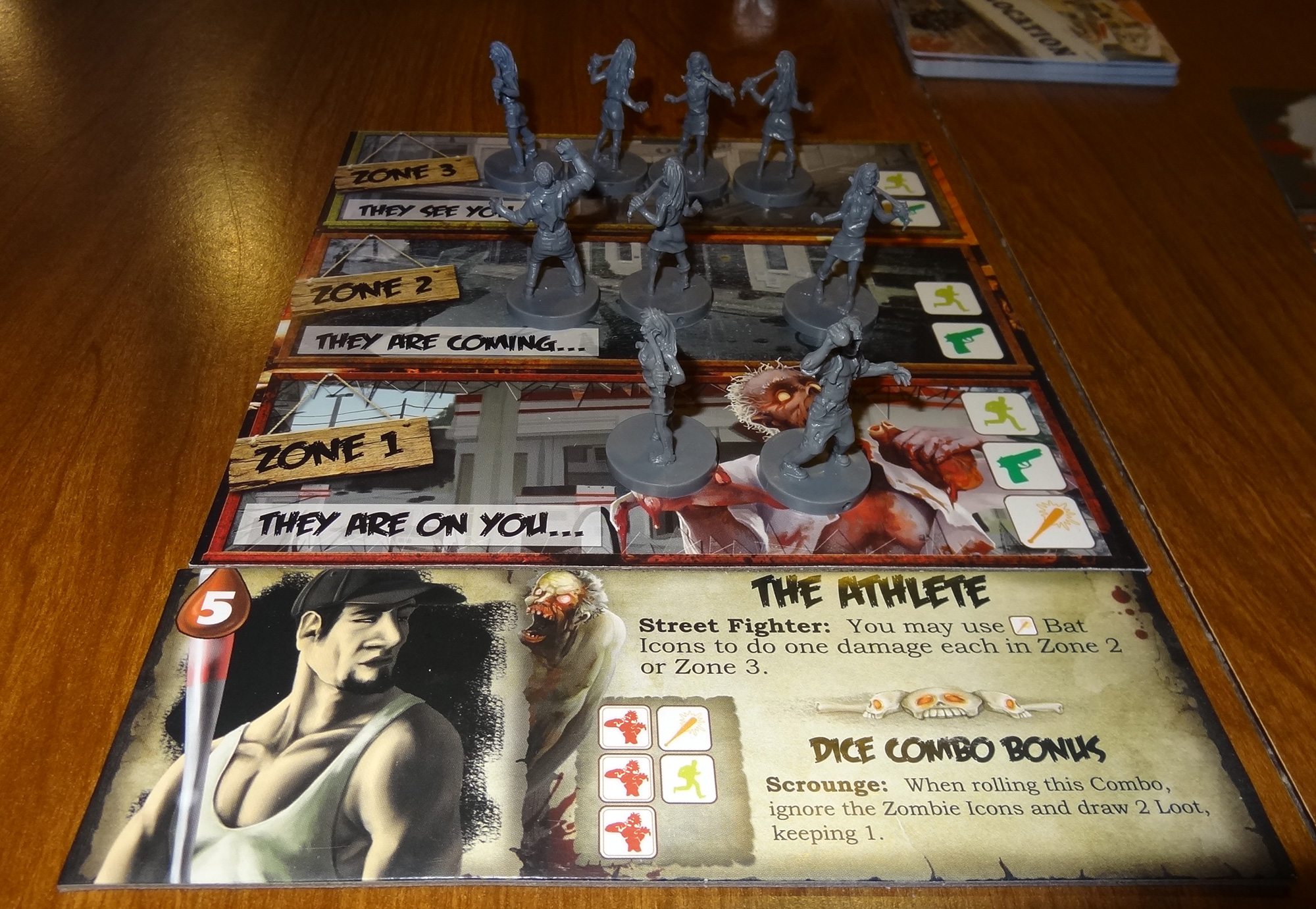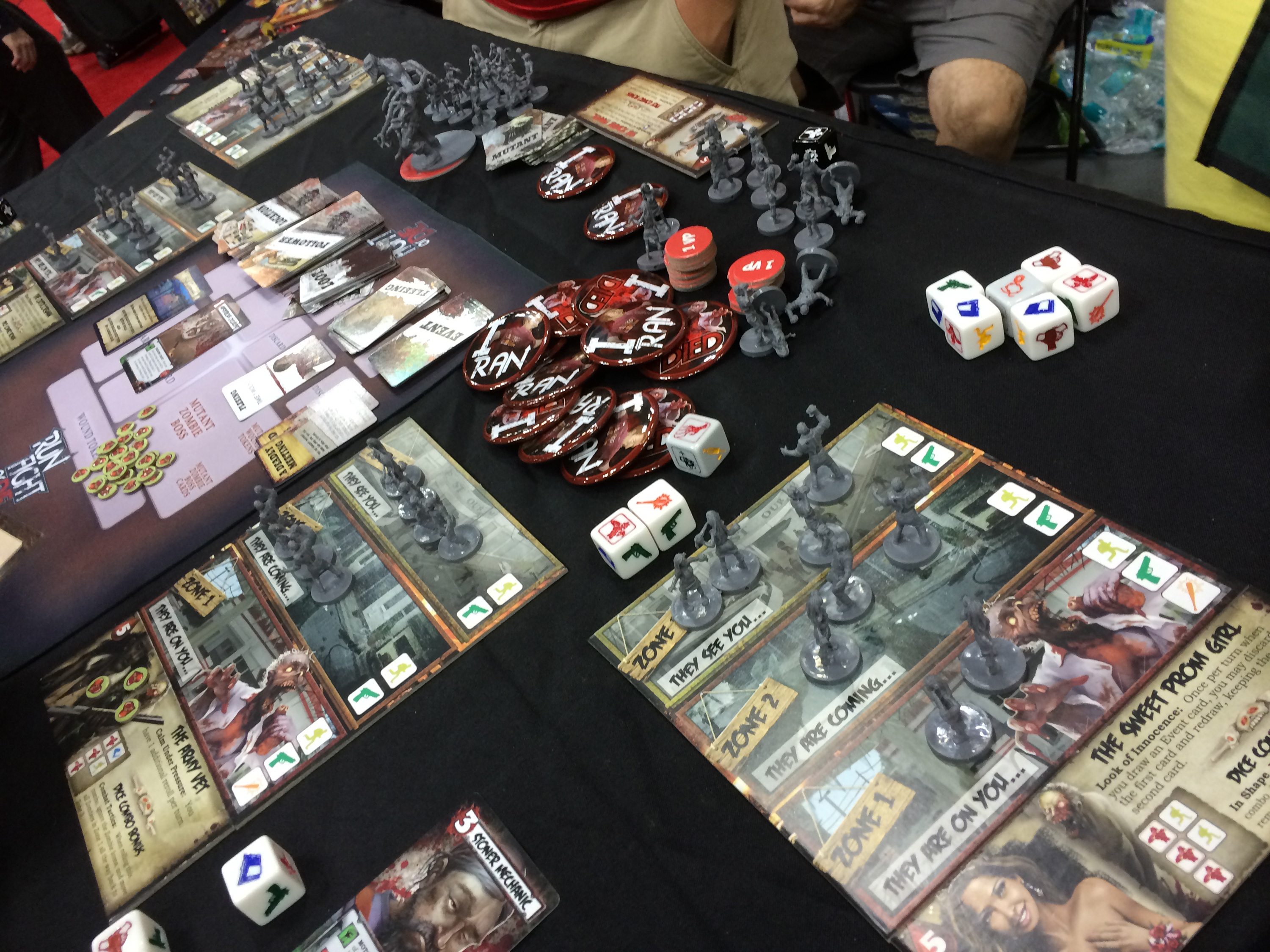A friend commented to me that zombies have become like bacon—people just add them to everything. Well, I have to admit that I’m a sucker for zombies. But, hey, apparently so are lots of other gamers. There are tons of zombie-themed games (Last Night on Earth was one of my first and still one of my favorites) and more coming all the time. Here are just a few that I saw at Gen Con this year that I think are worth mentioning.

Despite the fact that I wish Run, Fight or Die! used a serial comma in the title, it’s a fun dice-based zombie game (or zombie-based dice game) that uses some elements of Yahtzee with what amounts to an unending conveyor belt of zombies coming your way. It was funded on Kickstarter last winter, and shipped to backers shortly before Gen Con. I saw it while I was at the show, and got a review copy to try out for myself.
At a glance: Run, Fight or Die! is for 1 to 4 players (up to 6 with the optional expansion), ages 13 and up, and takes 30-60 minutes to play. It retails for $49.99. Based on the content, I think it’s about PG or PG-13, although the gameplay isn’t too complex.
Components:
- 7 custom dice
- 4 Action boards
- 6 Player Character boards
- 25 Follower cards
- 18 Location cards
- 16 Loot cards
- 16 Fleeing cards
- 16 Event cards
- 24 Mutant Zombie Boss cards
- 20 Mutant Boss Wound tokens
- 25 Wound tokens
- 60 zombie miniatures
- 1 Zombie Mutant Boss token
- 1 player reference board
There are a lot of cards—some are mini-cards and some are full-sized. All of the cardboard bits are nice and sturdy, though the wound tokens are pretty tiny. The artwork is stylized with a slightly cartoony feel, which fits with the somewhat goofy characters (followers) you come across.
The custom dice are pretty nice: oversized and chunky, with the icons engraved and painted. There are two types of miniatures, males and females, though they’re equivalent in the game. The reference card is a stiff cardboard with text on both sides, and you’ll be passing it around frequently to remember all the various combinations.
There were a number of extras that were only available through the Kickstarter (so I don’t have them) but I did see some of them at Gen Con. For instance, there were extra player boards and a plastic miniature of the mutant zombie boss, but in the retail version it’s just a large cardboard disk.

How to Play
The goal of the game is to have the most points by getting Followers and getting out of town alive. Sorry: if you die, you don’t get to win, even if you had the best Followers.
Everyone gets an Action board and a character, which fits at the bottom of the Action board. You start with 9 zombies: 2 in Zone 1, 3 in Zone 2, and 4 in Zone 3. The zones represent how close the zombies are to you, and they’ll just keep coming. All the cards are shuffled individually to form their own decks. The black bonus die is placed near the middle until somebody needs to use it.
On each turn, you’ll roll the 5 action dice and the event die, and then you get two re-rolls for the action dice. The event die is resolved right away, and there are good and bad events: you may get extra zombies, a wound, or have to move some zombies toward you. Or you might get “All Quiet” so you spawn fewer zombies, or heal some wounds, or get to change a die to whatever you want.
The action dice have various symbols on them, plus a zombie. If you get a zombie, that die is normally locked and can’t be rerolled, and will add another zombie at the end of your turn. The other symbols include Bats, which kill 2 zombies in Zone 1; Guns, which kill a zombie anywhere; and Run, which moves a zombie back one zone (or off the board from Zone 3). The other two symbols, Search and the Book of the Dead, have different effects depending on how many of them you end up with. Search will let you get Follower and Location cards. The Book has a lot of different effects that you can choose from: drawing event cards, getting Loot or Locations, stealing Followers from other players, healing wounds, or even clearing zones of zombies—all depending on how many Book icons you roll. Once you’ve finished with your rerolls, you spend all the dice, killing or moving zombies on your board, and drawing cards as indicated.
During your turn, if you really want to re-roll your dice with Zombies on them, you have to take a Fleeing card as a penalty. Sometimes they’ll just add more zombies to your board, or you might lose loot or take wounds, or you might even awaken the zombie boss.

The Followers can give you bonuses or penalties (or sometimes both). Generally, the more powerful the abilities, the fewer points they’re worth. For instance, there’s a screaming cheerleader who’s worth more points, but every turn you’ll have to add two zombies to your board. There are some, like the Town Drunk, that require you to spend a Run icon to chase after him, or he wanders off to the next player at the end of your turn.
Loot is always good: you might get better weapons or med kits or other tools that will help you survive. Locations and Events can go either way: you might get something great, or you might hit a dead end and be surrounded by zombies. You never know.
Every so often, you’ll draw a card that brings out the mutant boss with a certain number of wound tokens. You can shoot at him on your turn, and if he runs out of wound tokens he goes away. Each wound you do to the boss is worth a point at the end of the game. But more importantly, killing him prevents him from wounding you: at the end of each turn, if the Boss is around, you’ll have to draw a card, which may spawn more zombies, move zombies forward, or just plain wound you.
At the end of your turn, all the zombies advance one zone. If they were on Zone 1 already, they wound you and get discarded. Finally, you’ll add 3 more zombies to Zone 3 (unless you rolled All Quiet), and as many zombies as you rolled on the action dice.

There are a couple ways for the game to end: first, if somebody dies, the game typically ends then. If a player gets 5 Followers, they can declare the game end, and everyone will get one more turn. There’s a Location called the Town Line, and if any player draws that then you’ll check the total number of Followers against the chart, and the game could end then. Finally, if all 20 mutant boss wound tokens have been taken, the game ends.
You get 1 point per health remaining, 1 point for each mutant boss wound token, and the point value of all your Followers. Highest score wins.
The Verdict
Run, Fight or Die! was designed by Richard Launius (of Arkham Horror fame, among other things) and apparently had made the rounds of gaming convention for years before being published by 8th Summit and distributed by Grey Fox Games. I had missed the Kickstarter but it raised nearly $100k, and there were a lot of people trying it and picking it up during Gen Con.
As a zombie game, I think it does a pretty good job of conveying the dread of hordes of zombies shuffling their way toward you. You can see them coming, and you clear out a few right nearby or run away, but there are always more behind them. It’s like a first-person perspective rather than a game where you can see yourself running around on a board. The game represents you out on the streets, constantly on the run, occasionally ducking into a location. With that in mind, I don’t feel that a story develops quite as much as when you play a game like Last Night on Earth where you can see your character on the board and you have a lot of different actions to choose from.

It’s a dice game, so obviously luck plays a big role in the game. If you’re not a fan of dice, Run, Fight or Die! won’t change your mind. However, if you do like dice games, the game does offer you some choices during gameplay—you can try to just go for the Bat, Gun, and Run to clear off your board, but that won’t get you any points. Or you can try to get enough Books to clear off entire zones of zombies. But you do have to pay attention to getting Followers, because without those you can’t get very many points to win the game.
The cards also introduce a luck element: Loot is always good, and Fleeing is always bad, but the Events and Locations can be either way. So although rolling a Search icon is better than a Zombie, sometimes you’ll wish you had kept running instead of visiting a Location.
I’ve played Run, Fight or Die! with different crowds, and have gotten different responses—some have really liked it, and some weren’t impressed. It’s quite a bit more involved than Yahtzee or King of Tokyo because of all the card effects, but quicker to play than some of the other big zombie games because it’s a very simple setup. With a lot of players, there will certainly be downtime as you wait for somebody to take their turn. On the other hand, if you like the feeling of being chased down by an ever-growing mob of zombies, it might be just the thing.
Disclosure: GeekDad received a review copy of Run, Fight or Die!
Next up: Student Bodies from Smirk & Dagger Games.


